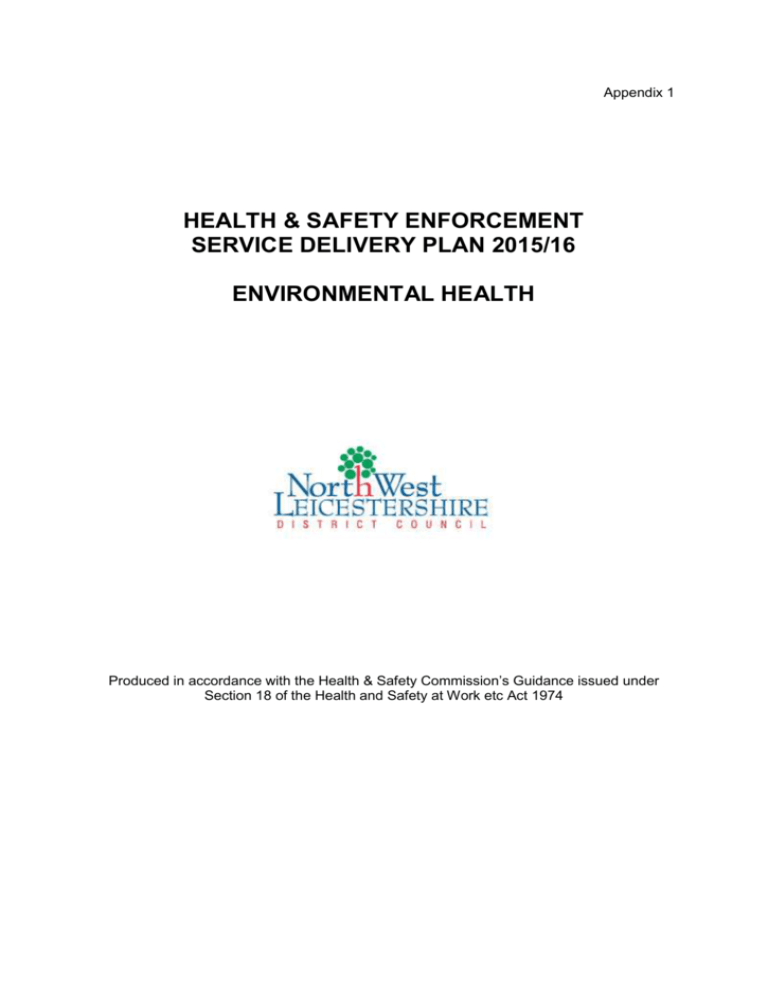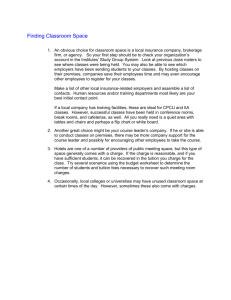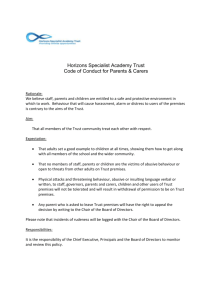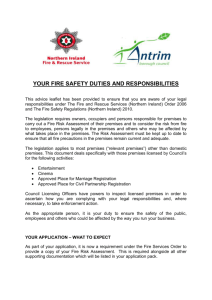TECHNICAL & CONTRACTING SUPPORT DIVISION
advertisement

Appendix 1 HEALTH & SAFETY ENFORCEMENT SERVICE DELIVERY PLAN 2015/16 ENVIRONMENTAL HEALTH Produced in accordance with the Health & Safety Commission’s Guidance issued under Section 18 of the Health and Safety at Work etc Act 1974 HEALTH & SAFETY ENFORCEMENT SERVICE PLAN 2015/16 CONTENTS PAGE No 1. INTRODUCTION 2 2. SERVICE AIMS AND PRIORITIES 2 3. SERVICE SCOPE & DEMANDS 3 4. SERVICE DELIVERY 2015/16 5 4.1 4.2 4.3 4.4 4.5 4.6 Priorities Targeting Poor Performing Premises Programmed Interventions Reactive Interventions Consultations Liaison with Other Organisations 5 5 6 7 8 8 5. RESOURCES 8 5.1 5.2 5.3 5.4 Financial Allocation Staffing Capacity Staff Development Issues for 2015/16 8 9 10 10 6. REVIEW 2014/15 11 6.1 Performance Review against the Service Plan 1 11-13 HEALTH AND SAFETY ENFORCEMENT SERVICE PLAN 1. INTRODUCTION This Service Plan is an expression of this authority’s commitment to the development of the Health and Safety Service and is a requirement of the Health and Safety Commission (HSC) as the body that monitors and audits local authorities activities on health and safety enforcement. The format and content of this service plan incorporates mandatory guidance issued by the HSC under Section 18 of The Health and Safety at Work etc. Act 1974. This plan should be read in conjunction with the Environmental Health Team Business Plan 2015/16 2. SERVICE AIMS, OBJECTIVES, SERVICE STANDARDS AND PRIORITIES 2.1 Our Mission Together with the Health and Safety Executive, our mission is to prevent death, injury and ill health to those at work and those affected by work activities. 2.2 Service Aims To work with others to protect people’s health and safety by ensuring risks in the workplace are managed properly. To protect the health and safety of the public and employees affected by work place activities enforced by the Local Authority in North West Leicestershire and to reduce accidents in the workplace through enforcement and education. To enable businesses to prosper and grow 2.3 Service Objectives 2.3.1 To support the Government’s ‘Strategy for Workplace health and safety in Great Britain to 2010 and beyond’. This sets the following targets: To develop new ways to establish and maintain an effective health and safety culture in a changing economy, so that all employees take their responsibilities seriously, the workforce is fully involved and risks are properly managed; To do more to address the new and emerging work-related health issues; To achieve higher levels of recognition and respect for health and safety as an integral part of a modern, competitive business. 2.3.2 To provide health and safety interventions that form part of the national strategy to reduce accidents, ill health and sickness absence through participation in national and local campaigns. 2.3.3 To provide assured health and safety advice and guidance to businesses to enable businesses to be successful. 2.4 Service Standards All service users can expect and will receive an efficient and professional response. 2 Officers will identify themselves by name in all dealings with service users. Officers will carry identification cards and authorisations at all times. Service users will be informed of the name and telephone number of the officer who is responsible for dealing with their service request. All complaints will be responded to. The following initial response times to service requests can be expected by service users:Immediate Fatalities Situations providing a risk of serious personal injury (this includes where the risk is one of traumatic (acute) injury and where the risk is from a long term health hazard which will ultimately contribute to damage to health). Within 3 Days All health and safety related complaints. Health and Safety Inspections Following a health and safety inspection proprietors will receive a letter within 14 days. The letter will contain details of how to make representations to the Environmental Health Team Leader - Safety. 2.5 Link to Corporate Priorities The aim of the service is to ensure that employees are safe and are healthy in their workplace. The work contributes to two of the Councils priorities and outcomes ‘Business and Jobs – Businesses choose to locate in our district’, and ‘Homes and Communities – People feel safe in their community’. 3. SERVICE PLANNING & DEMANDS 3.1 Service Planning 3.1.1 The enforcement of the Health and Safety at Work etc. Act 1974 is split between Local Authorities and the Health and Safety Executive. Local Authorities enforce health and safety in retail/wholesale premises (includes sale of a service), offices, hotels and leisure activities. HSE enforce in manufacturing and processing industries, transport undertakings, health service and education. 3.1.2 A national review of health and safety legislation recommended HSE be given a stronger role in directing Local Authority health and safety inspection and enforcement activity. In May 2013 the HSE published the National Local Authority Enforcement Code, which effectively directs local authority activity. Local Authority Circular (LAC 67/2 (revision 4) provides guidance and tools for priority planning and targeting activity. In addition to national prioritises identified by HSE, a work plan can deliver local priorities. 3.1.3 The LAC states that; ‘It is important that Las are able to justify any inspections they undertake and to confirm to the general Hampton principle of; “no inspection should take place without a reason”. Local Authorities are required to consider the full range of interventions at their disposal for managing health & safety risks in their community, these are: Proactive interventions 3 1. Partnership working 2. Motivating senior managers 3. Supply chain 4. Design and supply 5. Sector and industry wide initiatives 6. Working with those at risk 7. Education and awareness 8. Inspection (restricted to high risk premises and poor performers only) 9. Intermediaries 10. Best Practice 11. Recognising good performance Reactive interventions 1. Incident and ill-health investigation 2. Dealing with issues of concern 3.2 Service Demands 3.2.1 There are currently 1172 open premises recorded on the database where this Authority is responsible for enforcing health and safety legislation. Inspections have been carried out in 761 of the above mentioned known premises and a risk rating has been assigned to them in accordance with the nationally recognised scheme. (LAC 67/2 (revision 4). 3.2.2 Premises will receive a risk rating based on their health and safety performance. The risk ratings will assist in determining intervention priorities. However, risk ratings alone should not be used to determine the use of a particular intervention or to decide an intervention frequency. 3.2.3 The risk profile of premises in the district on 1 April 2015 was:Risk Category A (Highest Risk) B1 B2 C (Lowest Risk) Unrated Total Number of Premises 2 51 210 498 411 1172 3.2.4 The number of businesses owned by ethnic minorities whose first language is not English has no significant impact on the service. 3.3 Enforcement Policy The Compliance Code, replacing the Regulators’ Compliance Code was published on 25 July 2013. Officers within the Health and Safety Team take into account the principles of good enforcement set out in the Code. The Council’s general enforcement policy and specific health & safety enforcement policy are compliant with the Regulators’ Code. Through the Environmental Health Services work the Council will contribute to the principles of the HSC document “A strategy for workplace health & safety in Great Britain to 2010 and beyond”. This document has four key elements: 4 Developing closer partnerships Helping people to benefit from effective health & safety management and a sensible health & safety culture Focussing on enforcing authorities’ core business and the right interventions where we are best placed to reduce workplace injury and ill health Communicating the vision 4. SERVICE DELIVERY 2015/2016 4.1 Priorities 4.1.1 As a consequence of the new national guidance explained at paragraph 3.2.4 this authority will use a range of interventions available to influence behaviours and improve the management of risk. All interventions will be outcome focussed. 4.1.2 The work plan is designed to deliver the following outcomes: 4.2 The Council has the ability to determine the key risks of serious workplace accidents; injuries and ill-health. The Council has the ability to identify premises with a history of non compliance. The public feel safe when visiting/attending large public events held in the District. The risk of fatalities/injuries resulting from being struck by vehicles within the warehousing/distribution sector is reduced. The risk of fatalities/injuries resulting from employees warehousing/distribution sector falling from height is reduced. The risk of fatalities/injuries resulting from inadequate crowd control at large public events is reduced. The number of fatalities/injuries to the public resulting from motorised leisure pursuits / track days is reduced. The risk of infection resulting from swimming/bathing in public pools is reduced. at Targeting Poor Performing Premises Although a high proportion of workplaces in the District have been inspected, undoubtedly, a high proportion of the premises will have changed ownership since many of the inspections would have been carried out ten or more years ago. There is no premises registration system within the UK to assist with planning health and safety interventions, hence the authority receives no notification of businesses as they open or cease trading. Consequently targeting resource and interventions at those premises where there is a key risk of injury is challenging. In order to improve the information held, NWLDC will be developing a data exchange protocol with other members of the Leicester and Leicestershire Regulatory Services Partnership. 4.3 Programmed Interventions by Environmental Health Safety Team 5 4.3.1 Proactive Inspections Proactive inspections will be carried out at all premises rated as a ‘Category A’ and where intelligence shows that risks are not being effectively managed. Officers will also target any matters of imminent concern that appear to them in the course of a visit. An inspection may be carried out following an investigation being undertaken. 4.3.2 National, Regional and Local Priority Intervention Programme Premises within the following high risk sectors/activities will be targeted for proactive intervention: High Risk Sector Warehousing/ Distribution (high volume) Warehousing/ Distribution (high volume) Large scale public events Leisure / motorsport pursuits including off road vehicles and track days High Risk Activity Workplace transport Type of Intervention Inspection Working at height Inspection Inadequate consideration of public safety e.g. poor organisation and/or supervision Poor organisation and/or supervision of high speed vehicle movements Motivating Senior Managers Education and Awareness Motivating Senior Managers Outcome Risk of fatalities/injuries resulting from being struck by vehicles is reduced Risk of fatalities/injuries resulting from falling from height is reduced Risk of fatalities/injuries resulting from inadequate crowd control is reduced A reduction in the number of fatalities/injuries to the public Inspection Premises within the following medium risk sectors/activities will be targeted for intervention: Swimming / spa Poor organisation Education and pools and/or management Awareness of water safety/quality Water Sampling 4.3.3 Risk of infection from swimming/bathing in public pools is reduced Licensing & Registration The Team is involved in registering premises and individuals performing electrolysis, ear piercing, acupuncture and tattooing. 4.3.4 Smoking Controls in all Enclosed Public Areas and Workplaces 6 The ban on smoking in workplaces and all enclosed public places came into force on July 1st 2007. This legislation is enforced by Environmental Health Officers and Licensing Enforcement Officers. Enforcement and Advisory work will continue to be a part of the routine work undertaken. 4.4 Reactive Interventions by Environmental Health Safety Team 4.4.1 Accident Investigations Council policy “to investigate accidents notified under the requirements of the Reporting of Injuries, Diseases and Dangerous Occurrences Regulations 1995 which meet the selection criteria laid down within LAC 22/13 and internal procedure note PNHS 2.0: Accident Investigations In deciding which accidents to investigate regard shall be had to the severity and scale of actual harm, the seriousness of any potential breach of the law and previous history of the duty holder. Generally, the following categories of accident will be investigated: 4.4.2 All fatalities arising out of work activities; Certain incidents reportable under RIDDOR namely – defined major injuries, diseases and dangerous occurrences related to the severity of the outcome; All RIDDOR incidents where there is likely to have been a serious breach of health and safety law. Complaints about Health and Safety Failings Council policy “To deal with issues of concern and complaint relating to health and safety practices/conditions and to advise all complainants of the outcome”. Complaints fall into three broad categories: 4.4.3 Complaints about unsafe working conditions or practices Complaints about welfare related issues i.e. working hours, breaks, temperature Complaints about lack of suitable training, supervision or instruction of employees Advice to Business/Employees/Public Council policy “to provide advice on health and safety to business, employees and the public”. The Leicester and Leicestershire Regulatory Services Partnership was formed in 2011. The overriding objective of the Partnership is to improve engagement with local businesses and to deliver regulation in a way that reduces the burden of regulation on business. 4.4.4 Notifications of Licensed Asbestos Removal Work Council policy “to assess all Licensed Asbestos Removal Notifications and visit site to check method of work and compliance with law”. 7 The Team receives notifications of licensed asbestos removal work which is to be carried out in Local Authority enforced premises. Due to the serious risk arising from exposure to asbestos dust during asbestos removal or repair all such works need to be assessed and visited. 4.4.5 Notifications of Defects in Lifting Equipment Council policy “all notifications of defects in lifting equipment will be investigated”. The Team receives notifications from insurance and engineering companies regarding defects requiring repairs in forklift trucks, lifts and other lifting equipment. These require investigation to check that companies have carried out these repairs to remove any risk to health and safety. 4.4.6 Firework Safety – Voluntary Registration Scheme Firework displays and bonfire events can present an unacceptable risk to the public if not organised and managed effectively. A voluntary registration scheme was devised in 2012 and will be offered again in 2014. Any event organiser can voluntarily register their event and will receive free health and safety support and advice from a member of the Safety Team. 4.5 Consultations The Team will comment on the arrangements relating to public safety on any new and variation premises licence applications received under the Licensing Act 2003. Under the Gambling Act 2005 the team are consulted by the Licensing team on applications received. 4.6 Liaison with Other Organisations The Council is represented on the following groups:External groups: Leicester, Leicestershire and Rutland CIEH Health and Safety Best Practice Group Leicester, Leicestershire and Rutland CIEH Managers Group Leicester, Leicestershire Regulatory Services Partnership Download Festival Event Planning Group Cattows Farm Event Planning Group Cattows Farm Residents Forum Donington Park Consultative Forum Internal groups: Business CAT 5. RESOURCES 5.1 Financial Allocation The budget for the provision of the health and safety enforcement service is £86,883 8 5.2 Staffing Capacity It is the Council’s policy to authorise officers appropriately as per their qualifications and experience. All Officers have been authorised as per internal procedure PN5.0: Authorisation of Officers. 5.2.1 The details of the staffing levels in the Team are as follows:Environmental Health Team Manager – The post holder has responsibility for health and safety enforcement, food safety and licensing and is fully authorised under the Health and Safety at Work etc Act 1974. Health and Safety related work = 0.1 FTE – Non operational Environmental Health Team Leader – The post holder supervises the work of the health and safety and food teams. The post holder is fully authorised under the Health and Safety at Work etc Act 1974. Health and Safety related work = 0.2 FTE. A proportion of this capacity is supervisory Environmental Health Officer – The post holder carries out duties under the Health and Safety at Work etc. Act 1974 in addition to food safety duties. The post holder is fully authorised under the Health and Safety at Work etc Act 1974. Health and Safety related work = 0.3 FTE Environmental Health Officer – The post holder carries out duties under the Health and Safety at Work etc. Act 1974 in addition to food safety duties. The post holder is fully authorised under the Health and Safety at Work etc Act 1974. Health and Safety related work = 0.2 FTE Environmental Health Officer – The post holder carries out duties under the Health and Safety at Work etc. Act 1974 in addition to food safety duties. The post holder is fully authorised under the Health and Safety at Work etc Act 1974. Health and Safety related work = 0.2 FTE Environmental Health Technician– The post holder is not authorised as an Inspector under the Health and Safety at Work etc. Act 1974. Environmental Health Technical Assistant - The post holder is currently seconded to the licensing team. The post remains vacant Technical Administrator – The post holder provides support to the Team. Administrative Health and Safety related work = 0.1 FTE Senior Technical Administrator - The post holder provides support to the Team. Administrative Health and Safety related work = less than 0.1 FTE 5.3 Staff Development The Environmental Health Team has embraced the principles of the Best Employee Experience (B.E.E) Project. Individual performance and development reflection meetings are a key element of North West Leicestershire District Councils performance management framework. An individual’s generic training needs are identified through this process. In addition the RDNA Tool is used to identify an individual’s technical based training needs. 9 Training courses on specific health and safety subjects are frequently hosted and run by the Leicester, Leicestershire and Rutland CIEH Health and Safety Best Practice Group. Key areas for training this year will be collated by each local authority and reported to the County group to form a training plan. 5.4 Issues for 2015/16 To review the premises listed on the IDOX UNI-form database and undertake works to ensure its accuracy and completeness. To develop a data exchange protocol with other regulators sharing data relating to compliance and new businesses. To increase the level of support and advice provided to businesses by promoting the LLEP Business Gateway and Better Business for All programme. 10 6. REVIEW 2014/2015 6.1 Performance Review Against the Service Plan 6.1.1 Proactive Inspections Premises were targeted to receive a health and safety inspection as a result of being categorised as high risk (category A) or being identified as a ‘poor performer’. The activities/sectors selected for proactive inspection were taken from a list of ‘high risk’ activities published by the Health & Safety Executive. The following provides a summary of activity carried out: Motor Vehicle Repair (as part of car sales) The focus of this intervention was the activity of using two-post vehicle lifts. The aim was to identify unsafe work equipment / activity. All garages within the District were contacted to identify the types of vehicle lifts in use and to determine the main activity on site in order to identify the appropriate health and safety enforcement allocation for HSE/ LA. 30 garages were contacted. Visits were made to 3 premises found to be operating two-post vehicle lifts. All 3 premises were found to be compliant with the law. Each business was provided with health and safety advice. High Volume Warehousing and Workplace Transport Warehousing and distribution, as a business sector, had the second highest number of accidents per 100 premises at 39. This formed the rationale for a health and safety intervention. The aim of the intervention programme was to assess legal compliance, raise the awareness of duty holders of key health and safety risks and precautions affecting warehouse operations and to promote best practice to duty holders. Visits were made to 5 premises with a focus placed on workplace transport issues. All 5 premises were found to have minor non-compliance with each business working towards achieving compliance. Large Scale Public Events North West Leicestershire hosts many large scale public events such as the Download Music Festival, Strawberry Fields Music Festival, Zoo project festival, Gatecrasher and a number of high profile motorsport events at Donington Park Motor Racing Circuit. For this reason leisure, as a business sector consistently has the highest number of accidents reported to this authority each year. The aim of this intervention programme was to raise the awareness of duty holders of key health and safety risks and precautions affecting employees and members of the public attending the event and to promote best practice to duty holders. The Environmental Health team actively participated in the planning of the Download Festival, Zoo Project festival and Strawberry Fields music festival by attending multiagency planning meetings and providing advice and guidance on the event management plans. An Officer attended these music events providing health and safety advice to the event organiser and addressed any matters of concern identified. 11 In addition advice and guidance was given to the organisers of other events such as the Gatecrasher event at Donington Park, the Moira folk festival and Moira Canal festival through to critique of draft event management plans and event risk assessments. Motorsport A programme of support and guidance was given to the management team at the Donington Park motor racing circuit. A member of the Environmental Health team provided health and advice enabling them to ensure that adequate arrangements are in place for the health, safety and welfare of their employees and other persons visiting the site. The focus of the work was safety within the paddock area which has resulted in a review of risk assessments and changes made to the control of vehicle movements. 6.1.2 Non-inspection Interventions Beauty Sector The focus of this intervention was premises carrying out beauty treatments such as tattooing, electrolysis, piercing and nail bars. The purpose of the intervention was to assess hygiene standards and provide each business with necessary advice to further improve. Telephone calls were made to 45 businesses to establish the nature of the beauty treatments being offered. This work identified that a number of premises and persons carrying out treatments were doing so without the required registration. 20 businesses were visited, 12 receiving an inspection. Although elements of non compliance were noted, the premises visited were found to be broadly compliant. 6.1.3 Swimming Pool Sampling Swimming/Spa Pool water samples - Total % unsatisfactory 6.1.4 2012/13 157 2013/14 130 2014/15 149 4% (5) 11% (17) 3% (4) <1% 2011/12 160 2012/13 136 2013/14 164 2014/15 167 51 35 10 53 56 96 33 69 2013/14 21 2014/15 23 Accident Investigations Workplace incidents/diseases/dangerous occurrences reported to Team - Total Number investigated Number related to activities at Donington Park Motor Racing Circuit 6.1.5 2011/12 122 Complaints about Health and Safety Failings Complaints about H&S failings - Total 2011/12 24 12 2012/13 36 6.1.6 Advice to Business/Employees/Public The Team gave health and safety advice over the telephone to a considerable number of businesses. The total number of calls is not recorded. H&S requests for advice resulting in research or visit 6.1.7 2013/14 15 2014/15 17 2011/12 4 2012/13 1 2013/14 0 2014/15 1 2013/14 2 2014/15 2 Notification of Defects in Lifting Equipment Defects in Lifting Equipment – Total notifications 6.1.9 2012/13 19 Notifications of Licensed Asbestos Removal Work Asbestos Removal - Total notifications 6.1.8 2011/12 36 2011/12 1 2012/13 1 Registrations issued for premises/individuals for performing electrolysis, ear piercing, acupuncture and tattooing Premises Registrations issued Persons Registrations issued 2011/12 10 15 2012/13 6 12 2013/14 9 9 2014/15 20 25 6.1.10 Licensing Applications Officers from the Safety Team were consulted following receipt of new applications and applications to vary existing licences. Total variation / new applications (LA2003) result in a in research or a representation being made 2011/12 35 2012/13 30 (15 new / 15 variation) 2013/14 15 (9 new/ 6 variation) 2014/15 19 (10 new/9 variation) 6.1.11 Enforcement Action Compliance with health and safety law increased as a result of the provision of advice and support and enforcement actions. Warning letters requiring improvement works were sent to a number of businesses visited. However no formal enforcement actions such as prohibition or improvement notices were served. No cautions were issued or prosecutions were taken. 13





